Felt with cut-out will soften highs for sure, that's what Mike Dzurko used in most of his designs. Also depending on what crossover design you use, flat FR might not be answer.
Felt with cut-out will soften highs for sure, that's what Mike Dzurko used in most of his designs. Also depending on what crossover design you use, flat FR might not be answer.
Well, many thanks for your suggestion.
I would like to look into diffraction but also including different angles, then take the average over listening window, say 30 deg (+/-15), more if you have small reflective room and very wide dispertion. I usually try to have freq resp that slopes gently down from say 1kHz to have nice power response and tweeter lower in level than mid around crossover. LR4 say 2-2.5k will have dip power resp followed by peak, so I try to compensate for the peak or things will sound overly bright. Then it also depends on distortions, directivity, cone break ups, bla, bla.
SoundStageNetwork.com | SoundStage.com - Loudspeaker Measurements Listed
Measurements done in Ottawa's NRC anechoic chamber
SoundStageNetwork.com | SoundStage.com - Loudspeaker Measurements Listed
Measurements done in Ottawa's NRC anechoic chamber
I would like to look into diffraction but also including different angles, then take the average over listening window, say 30 deg (+/-15), more if you have small reflective room and very wide dispertion. I usually try to have freq resp that slopes gently down from say 1kHz to have nice power response and tweeter lower in level than mid around crossover. LR4 say 2-2.5k will have dip power resp followed by peak, so I try to compensate for the peak or things will sound overly bright. Then it also depends on distortions, directivity, cone break ups, bla, bla.
...cut...
Well, I think you've centered solution. Just, because I'm not ready to well manage power response, is it lowering tweeter as you said the way to compensate the peak in power response after the dip of a LR4 net?
Does a LR2 work in the same way with a peak after dip?
Thank you.
Tweeter face plate looks recessed, not flush. Screws could do with being recessed and having some sort of putty smoothed over. Tweeter almost the same distance from 3 edges. (distances seem to match wavelengths of 5k to 8k)
Maybe try a layer of felt with a cutout for the dome. I think I remember an interesting 'star' shaped cutout to smooth the transition (Planet10 maybe?)
Rob.
Please, do you refer to this mounting solution?
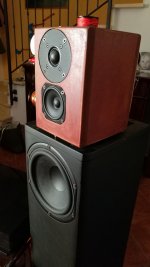
Isn't it a flush mounting? I've always took for granted that this is the correct way to mount every driver..
What do you intend for same distance from 3 edges? Is that a better way to fight diffraction rather than different distance as I've made?
Thanks
It looks like a diffraction artifact. The wavelength it happens is around 8,5 cm. It may not be a coincidence that you find that same dimension in your loudspeaker (it is half the width of your tweeter enclosure).
Actually, I think the result with the bare tweeter is slightly worse. The dip in the enclosure is deeper, but higher Q (narrower) than that with the tweeter outside the enclosure. High Q peaks and dips are less audible than low Q peaks and dips.
...cut...
Please for 'bare' tweeter do you intend this solution right?
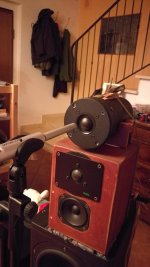
Here's the overlay between black trace of bare tweeter and gray trace of baffled tweeter:
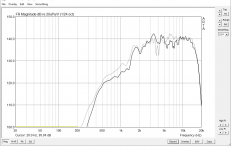
Do you mean that grey trace is better than black one?
Thank you.
Are you tried to dial down the tweeter level a few dB?
In small reflective rooms there is usually too much high frequency energy in the lower to mid treble if the speaker tuned to flat on-axis response because of the very wide dispersion of the tweeter below 5-6 kHz.
The peak around 3 kHz just makes things worse, which seems a diffraction effect. Imo this is a good example why waveguides are developed, especially for tweeters.
Because of a waveguide shrinks tweeter's output field and reduces interactions with what lays just around it on its mounting plane, do you think I can adopt succesfully this bare solution with a waveguide added?
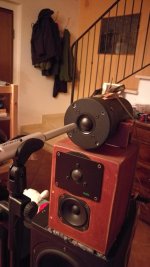
Despite the weakness of this solution as said by AllenB, may using a waveguide make it a good solution? If waveguide makes tweeter less sensitive to its immediate around, would it be less sensitive to the blankness of tihs solution's around?
Thank you
If waveguide makes tweeter less sensitive to its immediate around, would it be less sensitive to the blankness of tihs solution's around?
A round waveguide like the WG148R may not the best suitable for a baffleless mounting, because the baffle is the waveguide itself in this case and with the round form, the edge is at the same distance in every direction, except below which is the box.
Although the round baffle effect is reduced thanks to the limited dispersion.
There are a rectangular version of the Visaton wg, but its huge.
Just try it and you will see!
Last edited:
Good point about the degree of establishment of the baffle conditions.Although the round baffle effect is reduced thanks to the limited dispersion.
Thanks Allen!
Anyway, I ordered a WG148R a few weeks ago and just waiting to arrive. I may report back how it works with or without baffle.
Anyway, I ordered a WG148R a few weeks ago and just waiting to arrive. I may report back how it works with or without baffle.
Thanks Allen!
Anyway, I ordered a WG148R a few weeks ago and just waiting to arrive. I may report back how it works with or without baffle.
Just ordered too, we may make a cross check : )
I choose the circular version because I'm not sure the rectangular can fit my tweeter, by photos and drawings flange seems slight different while the circular instead is adaptable for sure; in the end, if things will go bad we'll be ever able to put around a rectangular baffle.
Good luck!
Here's the overlay between black trace of bare tweeter and gray trace of baffled tweeter:
View attachment 825382
Do you mean that grey trace is better than black one?
The Black trace has peak exactly where most people would prefer to have dip and it would make the spkrs sound overly bright, especially if the x-o point happens to be around 2k. The difference between LR2 and LR4 is that the peak in power response is more pronounced and sounds worse than in case of LR2. If you would move x-o to 3.5k the dip further up in freq resp would compensate nicely. What is the freq resp of the mid?
View attachment 825382
Do you mean that grey trace is better than black one?
The Black trace has peak exactly where most people would prefer to have dip and it would make the spkrs sound overly bright, especially if the x-o point happens to be around 2k. The difference between LR2 and LR4 is that the peak in power response is more pronounced and sounds worse than in case of LR2. If you would move x-o to 3.5k the dip further up in freq resp would compensate nicely. What is the freq resp of the mid?
Last edited:
Let's look at the freq chart vs perceived sound based on HD600 headphones that most people say is a very good sounding one - forget the fact that a bit different roles apply in headphone design.
HD600 | DIY-Audio-Heaven
Also look into North Creek - George used Scan 9500 a lot and made very good spkrs
EchoInfo
HD600 | DIY-Audio-Heaven
Also look into North Creek - George used Scan 9500 a lot and made very good spkrs
EchoInfo
Last edited:
...cut...
The Black trace has peak exactly where most people would prefer to have dip and it would make the spkrs sound overly bright, especially if the x-o point happens to be around 2k. The difference between LR2 and LR4 is that the peak in power response is more pronounced and sounds worse than in case of LR2. If you would move x-o to 3.5k the dip further up in freq resp would compensate nicely. What is the freq resp of the mid?
Ok that's clear, thank you, here's the midrange FR:
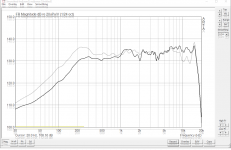
Black trace is @100cm against grey @5cm.
Does moving cross-point as you suggested compensate on-axis response or power response?
Is LR4 worse than LR2 in terms of power response or viceversa?
Does moving cross-point as you suggested compensate on-axis response or power response?
Is LR4 worse than LR2 in terms of power response or viceversa?
Textbook like LR2 have smoother power response than LR4 if the on-axis response is the same.
Textbook like LR2 have smoother power response than LR4 if the on-axis response is the same.
Please be patient, is there a method to measure power response??
Please be patient, is there a method to measure power response??
I suggest a measurement at the listening spot with the speakers in place, ungathed 1/3 octave or psychoacoustic (with REW) smoothing. Ime, this will show the LR2-LR4 difference too, and that is what you hear anyway.
I suggest a measurement at the listening spot with the speakers in place, ungathed 1/3 octave or psychoacoustic (with REW) smoothing. Ime, this will show the LR2-LR4 difference too, and that is what you hear anyway.
..ungated, right! Thank you, great suggestion!
The LR2 has lower peak in power response and sounds smoother than LR4, but you need nice drivers for LR2 with smooth freq resp - midbass without cone break up. It is also much harder to execute, since the phase of the drivers has to overlap over much wider bandwidth. Most 6-8" are not well behaved above 2k, have cone break up around 4k in many cases, plus directivity suffers therefore most designs use BW3 or LR4, or mix of the two. If tweeter is capable then LR2 @ 1.5-2kHz might be possible but very hard to do. Didn't try LR4-LR2 yet because don't have drivers that could do this. Years ago I built Focal 544 MTM with LR6-LR4 around 3k, tweeter didn't have ferrofluid so x-o was higher not to stress it. LR6 on woofer 'cause of cone break-ups.
To get approx of power response you need a lot of off axis measurements - Vituix can do approximate based on off axis measurements.
To get approx of power response you need a lot of off axis measurements - Vituix can do approximate based on off axis measurements.
- Home
- Loudspeakers
- Multi-Way
- May my problem be diffraction?